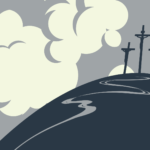The city hums with restlessness. Sirens, construction, and conversation coil around one another in a relentless liturgy of noise, desire, and urgency. In these concrete cathedrals of commerce, image, movement, and ambition, the soul often seems like an afterthought, something left behind in the commute or buried beneath the algorithm. Faith, in the modern city, can feel like a foreign dialect, a strange orientation, a useless past-time, a bygone superstition.
Yet, urban spirituality is precisely the place where the presence of God moves unseen, waiting not in escape but encounter, emerging not in retreat but in the sacred presence of Christ manifesting in the ordinary life of the city.
1. Practicing Presence in a Distracted Age
God isn’t absent in the urban jungle. But to find God here requires a new kind of seeing, a contemplative attentiveness that doesn’t flee the city’s chaos but finds stillness within it. The call isn’t to abandon the marketplace but to become monks of the metro, saints of the sidewalk, and contemplatives in the crowd.
“The soul doesn’t need a monastery to find God; it needs attention.”
The holy isn’t hidden from the secular world; it’s woven through it, waiting to be touched, named, and received. Anyone who says God’s holy and beautiful presence isn’t found in the mess, chaos, noise, and people of cities hasn’t been looking closely enough or paying attention to God.
This is where the old wisdom of practicing presence becomes urgent and subversive. The soul doesn’t need a monastery to find God; it needs attention. Urban spirituality requires a willingness to wake up, notice, and pray with eyes open in a world that wants them closed. The question isn’t whether God is present in secular spaces but whether we are.
2. The Spiritual Crisis of Forgetfulness
Many who dwell in cities now live without the scaffolding of institutional religion, communal worship, natural landscapes, silent retreat, or sacred rhythm. The economic calendar has replaced the sacred one. Sunday mornings are market or brunch time, and meaning is often shaped more by Netflix and newsfeeds than by Scripture, liturgy, or silence.
“The spiritual crisis of the city isn’t its secularity; it’s its forgetfulness.”
But the soul still hungers. Beneath the noise, people long for transcendence, rootedness, and peace that doesn’t come in a bottle or through a screen. The spiritual crisis of the city isn’t its secularity; it’s its forgetfulness. The Spirit is reaching out to hearts with love and grace, wanting people to remember their belovedness, sacredness, and connectedness to Someone larger than themselves, bigger than their fears and anxieties, more significant than their ambitions and desires, and grander than their skyscrapers and cities.
3. Finding Burning Bushes in the Digital Glow
In every city, the Spirit hovers above the concrete and steel, within the humanity and connections, bringing God’s shalom and redemption. Among the steel and digital glow are burning bushes, small moments of grace present in the ordinary.
“The city isn’t godless; it’s often just distracted.”
God’s grace breaks through as light filters through a train window; a stranger shows kindness on a crowded street or an unnoticed sparrow flitters across the pavement. These are sacraments, too. The city isn’t godless; it’s often just distracted.
We usually don’t find God in dramatic visions or spiritual highs but in the simple act of presence—washing dishes, sweeping floors, changing nappies, commuting to work, paying bills, smiling at strangers, riding elevators, and answering emails. In all these things and more, God is near. Practicing God’s presence means letting no moment be wasted, no space be too secular, and no task be too mundane to become a communion site. [1]
4. Altars on the Move
Jesus knew this. He taught on dusty roads, healed in marketplaces, prayed in lonely places, and wept outside the gates of cities. His ministry unfolded in the middle of human noise and need. Jesus noticed fig trees, fields, coins, lepers, sparrows, lilies, and children. [2] He moved slowly through crowds and saw what others ignored. His was a spirituality of deep presence, not detachment, a grounded way of being that saw through surfaces into the sacred center of things.
“The subway becomes a monastery, the café a cathedral, the workplace a chapel, and the park bench a prayer stool.”
To follow Jesus in the city isn’t to withdraw but to embody this same attentive love. The subway becomes a monastery, the café a cathedral, the workplace a chapel, and the park bench a prayer stool. We carry the inner room of stillness within us, even when the world spins fast around us. We become altars on the move, bearing grace in brief encounters, silent prayers, and small, intentional acts of love.
Of course, this takes practice. The soul must be trained to resist the tyranny of speed and spectacle. It must learn to breathe, listen, and be still, not in escape but in the heart of motion. Without such formation, the city will shape us in its image—restless, reactive, fragmented, distracted, always searching, and never arriving.
“The world doesn’t need more escape. It needs presence—deep, rooted, alert presence.”
But if we choose differently, if we surrender not to the noise but to love, we may find the sacred hidden in plain sight: in laughter shared between strangers, in the quiet dignity of work done well, in beauty glimpsed between buildings, in arms outstretched toward immigrants, in prayer whispered between meetings, in lament offered while walking through injustice, and in the quiet assurance that we are not alone, even when no one sees us.
The secular city may not speak the language of church bells, choirs, and incense, but it isn’t beyond the reach of God. Every pavement and platform can become holy ground. And the soul, even here, even now, can burn with sacred fire.
The world doesn’t need more escape. It needs presence—deep, rooted, alert presence. The kind that listens in traffic prays over spreadsheets and welcomes grace into every square inch of urban life. The kingdom of God isn’t elsewhere. It’s here.

“Jesus Christ still walks the streets. Will we walk with him?”
God’s loving presence is often hidden in noise, buried in busyness, and reaching out to us as we wait in line at the bank or post office. The Spirit of Christ longs to touch our hearts, reassuring us of our belovedness on subways, streets, office towers, and city parks. And Jesus Christ still walks the streets. Will we walk with him? Will we see God in our cities?
Graham Joseph Hill is the Mission Catalyst – Church Planting and Missional Renewal for Uniting Mission and Education. You can read his Blog here and his Substack here.











